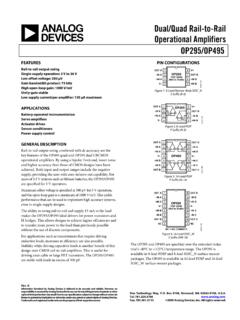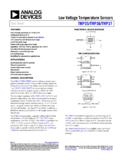Transcription of Lecture 17: Clock Recovery - Stanford University
1 EE 371 Lecture 17 MAH1 Lecture 17: Clock RecoveryAzita Emami Slides from Prof. M. HorowitzComputer Systems LaboratoryStanford UniversityCopyright 2001 by Mark HorowitzEE 371 Lecture 17 MAH2 Overview Reading Chapter 19 - High Speed Link Design, by Ken Yang,Stefanos Sidiropoulos Introduction One of the critical tasks in building high-speed IO is getting the receive Clock to be properly aligned to the incoming data. This means you need to control the phase (and sometimes the frequency) of the receive Clock . Clock alignment is usually done using a feedback system that controls the phase, and is called a phase-locked loop or PLL. There are two ways to build this kind of system, one using a voltage controlled oscillator and the other using a delay 371 Lecture 17 MAH3 Timing The timing (clocking) discipline dictates the transmission and sampling of the signals on the channel: determines how we generate the clocks that drive the transmitter and receiver ends of the link Clocking circuit design is tightly coupled with signal encoding for timing Recovery .
2 High-bandwidth serial links recover timing based on the transitions of the data signals (need encoded data to guarantee spectral characteristics) Low latency/parallel systems use a source synchronous discipline( transmitter Clock is sent along with the data) The basic circuit block is a Phase Locked LoopTxRxChannelT-clkR-clkEE 371 Lecture 17 MAH4 Outline Clock - Recovery /phase-alignment approaches Traditional CRCs Oversampled CRCs Source synchronous links Timing Loop Design Delay Locked loops Phase Locked loops Circuit Components Variable delay/frequency generation Phase Detectors FiltersEE 371 Lecture 17 MAH5 Classic Clock /Data Recovery Many different implementations ([1]-[5]) Data stream must guarantee transitions ( PSD content) State of system is stored in analog filterVCOPhDetFilterPLLD ecisionDOUTDINEE 371 Lecture 17 MAH6 Oversampled Clock /Data Recovery Oversample the data and perform phase alignment digitally Alternatives range from closed digital loop systems to feed-forward systems ([6]-[9]) De-couples the Clock generator from the tracking of the data Still data must guarantee transitions to ensure proper trackingPhDetFilterData Receiver clk0-NDINrefMulti-phase DelayselDOUTD0D1D2clk0clk1clk2clk3 Data RecoveryCLK PLL/DLLEE 371 Lecture 17 MAH7 Phase Alignment in Source Synchronous Systems Timing information is carried by an explicit Clock signal ([10]-[13]) State can be stored either in analog filter or digital logic DLLrefrefCLKD0D1D2D3data refCLKdataCLKCLKEE 371 Lecture 17 MAH8 Timing Loop Performance Parameters Phase Error: AC - jitter: The uncertainty of the output phase DC - phase offset.
3 Undesired difference of the average output phase relative to the input phase. Bandwidth: Rate at which the output phase tracks the reference phase Lock time, Frequency Range Duty cycle (in classic CRCs and most source synchronous systems) Spacing uniformity of multiple edges (in oversampled CRCs)clockw/o jittercloc kw/ jitter Time DomainPhase Histog ramEE 371 Lecture 17 MAH9 Loop Architectures: DLL vs PLL First order loop: easily stabilizable frequency synthesis a problem ref clk jitter passes through no phase error accumulation Second/Third order loop: stability is an issue frequency synthesis easy filtering of ref clk jitter phase error accumulationEE 371 Lecture 17 MAH10 Delay Locked Loop Controlled variable is delaythrough the VCDL Open Loop TF: Closed Loop TF: FilterVCDLref c lkclkDlyerrKpdKf/sKdlyKdly (sec/V)KpdKf (V/sec2)VCTLTs()KpdKfKdlys-------------- ---------------=Hs()KpdKfKdlysKpdKfKdly+ -------------------------------------=EE 371 Lecture 17 MAH11 DLL Dynamics Single pole system Stable as long as feedback delay is not excessive Jitter sources: Device noise: usually negligible Noise sensitivity of the delay line Noise sensitivity of the subsequent Clock buffer System issues: Phase noise of the input signal -> systems with DLL s require low jitter differential clocks Limited locking range -> need to ensure adequate VCDL range and employ special reset 1|H(s)|KpdKfKdlyEE 371 Lecture 17 MAH12 Interpolating DLL s Pick two successive coarse edges and then interpolate between them to generate the desired output phase [13], [22], [23].
4 No range boundaries on the generated delay Can use digital control CORE DLL0 1 2 3 4 5 ( = /6) = i = j (i = 0,2,4)(j = 1,3,5)Phase SelectionSelective Phase Inversion{ + { + Phase InterpolationFSM +(1 /16) ( - )Phase Detector( = ) = =PERIPHERALDLLrefCLKinCLK0 /2 3 /2EE 371 Lecture 17 MAH13 VCO-based Phase Locked Loop Controlled variable is phaseof the output Clock Main difference from DLL is the VCO transfer function: The extra VCO pole needs to be compensated by a zero in the loop filter:Filterref c lkclk errKpdF(s)KVCOKVCO (Hz/V)KpdF(s) (V/rad)HVCOs()KVCOs----------------=Fs() Kf1sz1 +()s--------------------------------=EE 371 Lecture 17 MAH14 PLL Dynamics Open Loop TF: Closed loop TF:Ts()KpdKf1sz1 +()Kvcos2------------------------------- -------------------------=Hs()KpdKfKvco1 sz1 +()s2 KpdKfKvco1sz1 +()+------------------------------------ -------------------------------=MagPh0o9 0o180o phase marginOpen-loop TF z140dB/decade Closed-loop TFKpd*Kf*KvcoMag1T(s)H(s) : we are adding proportional control (z1) to adjust the output phase while the lter integrator (pole at 1/s) holds the frequency infor mationEE 371 Lecture 17 MAH15 PLL Dynamics (cont d) Other effects that reduce PLL stability/performance [14]: Higher order poles: Suppress ripple but may compromise phase margin Sampled nature of the feedback system Keep bw< ref/10 Ultimately limits the lock range of the loop Phase error accumulation (VCO is an integrator : ): td =VsupplyVCDL delay/phaseVCOF reqphaseEE 371 Lecture 17 MAH16 PLL vs DLL: Phase Error Accumulation Simulated data for 6-stage PLL vs 6-stage DLL @250 MHz.}}
5 Supply sens: 20ps/element/Volt, supply-step: 300-mV @200-ns This would suggest that if no Clock multiplication is needed and the input Clock is quiet, the obvious choice is a DLL. However: Multiplication is often necessary from a system stand-point (EMI, Clock generator chips not fast enough) Jitter really matters on the 371 Lecture 17 MAH17 System Jitter A lot of energy is usually spent optimizing half of the problem: A state of the art inverter has a supply sensitivity of ~ 1%-delay/%-supply An average PLL/DLL has a supply sensitivity of < 1%-delay/%-supply -> If the Clock buffer delay approaches a cycle, more than half of the system jitter comes from that mattershereDLL/PLLclock bufferEE 371 Lecture 17 MAH18 Loop Components Variable delay/frequency generators Mainly built as voltage controlled delay elements Main issue is supply/substrate voltage sensitivity Phase detectors Linear and non-linear designs depending on the system Main goal is to achieve low offset Loop filters Almost always constructed around a charge pump Main issue is to minimize offset and ripple Other: Signal amplifiers, Supply de-couplingEE 371 Lecture 17 MAH19 Variable delay elements Delays in CMOS are usually generated by RC elements.
6 : Delay can be controlled by varying R (or I), C, or Vinv. All of the above can be changed easily, but the problem is that they also change with varying Process, Temperature, and Supply voltage : Process - Usually not a problem if the total variation is reasonable Temperature - Slowly varying -> well below the loop bandwidth voltage - Both supply and substrate change rapidly Design Goals:high supply & substrate noise rejection; adequate range RCVinvEE 371 Lecture 17 MAH20 Simple delay elements current starved inverter [15] Shunt capacitor inverter [16] Both have poor supply rejection (>= 1%delay/1%supply)VCtdVC controls dela y by limiting maxim um current through a standard inver ter tdVCVccontrols dela y by changing effective capacitance at the output nodeEE 371 Lecture 17 MAH21 Improving simple delay elements Make a high impedance current source to isolate completely the inverter supply Vs tracks Vss for frequencies higher than 1/rOC current source can be implemented as cascode or active-cascode [18] Or you can use a source follower to achieve a similar effect [17] What about substrate noise?
7 DEC makes ground and substrate the same node by supplying current to the inverters through the p-epi!! [18] OK, as long as max drop through epi resistor is small and constantVsrOCEE 371 Lecture 17 MAH22 Differential delay elements1. Isolate supply with a high impedance current source2. Increase CMRR by making signals self-referenced Ideally we need load elements that look like perfect resistors whose value is adjusted by the control voltage / current : Main problem: Create a resistor that is both variable AND linear ii-o+o-VctrlIbiasloadelementEE 371 Lecture 17 MAH23 Differential delay elements with linear loads Change the current through a linear-FET-loaded diff pair and adjust the gate voltage of the loads to change the resistance. Replica-feedback circuit keeps swing constant and the loads linear [6] Try to increase the impedance of the current source bycascoding -> small head-room Use a load with larger dynamic range [20]VCTRLi+i-o-o++-VREFS wing m ust be quite small to get a real resistiv e behaviorEven then transients might slightly satur ate the loads and decrease CMRREE 371 Lecture 17 MAH24A variable load with high CMRR FET s are non-linear but what we really need is to clamp the swing.
8 Also if load transfer function is symmetric CMRR is improved [19] Use replica feedback biasing to cancel substrate and supply noiseSum of transistor I-Vand diode-connected I-V curveIdsVdsVctrl@ various VctrlVbiasVctrli+i-o-o++-Replica loop k eeps the s wing of the buffers equal to Vctr lIn VCO s the replica loop bandwidth should be high enough to stop the VCO from accumulating phase error f or many cyclesWatch out for loop stabilityEE 371 Lecture 17 MAH25 Interpolative Delay GenerationCourtesy D. Foty Generate an edge based on the weighted sum of two other edges: Useful for: DLL s with unlimited phase shift Fine edge placement for oversampled CRCs Some designs use this technique even for their main VCO [4] Non-linearity might be large if input edges are spaced far apart relative to the time constant at the output node = [(N-weight) x + weight x ]/N weight = Load -I1 Itot-I1 +y- +EE 371 Lecture 17 MAH26 Phase Detectors Goal: Align the Clock to the right place ( the center of the data eye) Other requirements.
9 Fast acquisition Minimum dead-band ( area in which the PD is blind to its inputs)Use perfect PD and compensate set-up timePLL/DLLClk BufLinear errPLL/DLLClk BufReplica PDclk errUse replica PD to auto-compensate [13]data-inideal sampling point90o TsetuprefrefEE 371 Lecture 17 MAH27 Linear Phase Detectors XOR phase detector - 90olock sensitive to input duty cycle SR phase detector - 180olock 1-shots remove duty cycle sensitivity updnclkrefclkrefdn err0 /2dnuprefclkdnrefup1-shotclk1-shot err02 EE 371 Lecture 17 MAH28 Phase/Frequency Detector Aids in frequency acquisition Overlap up/dn pulses to eliminate dead-band Can implement flip/flops in various ways to maximize speed/operating frequency [18]-[20]DQRDQR clkrefupdnrstclkrefupdn err02 EE 371 Lecture 17 MAH29 Non-linear Phase Detector An ideal flip/flop should force a loop to lock at 0o The set-up time of the flip-flop will introduce phase offset Symmetric structures can eliminate this problem [16]
10 Can be used to cancel the set-up time of an input sampler [13] The loop dynamics change: The loop is now a bang-bang system which dithers around a locking point: Risky for a PLL, routinely done for DLL s. The dither magnitude depends on the delay through the loop and the loop-gain updnclkrefclkrefdn r- i0 offsetFlop/SamplerEE 371 Lecture 17 MAH30 Typical DLL Loop Filter A charge-pump acting a perfect integrator Kf=Ipmp/Cfilt/s. We could have static phase offset if Iupis not equal to Idn Does not matter much for a bang-bang loop Can be an important issue in linear PD-based loops current sources with high output impedance (cascoding) Differential charge pumps [23] Replica-feedback biased charge pumps [19]updnIdnIupCFILTEE 371 Lecture 17 MAH31 Typical 2nd/3rd order PLL filter For a VCO based PLL, insert a resistor in series with integrating C. Explicit C2is often used to suppress ripple. Implement resistor in high resistivity layer (poly, diffusion, well) Difficult: layer might not exist, or might not be well controlled, or have high TCVctrl FilterC2 CupdnIdnIupEE 371 Lecture 17 MAH32 PLL filter without real resistors Sum a proportional currentto an integrated current [21] : If Ro and Ip are scaled appropriately, we can achieve scaling of the loop bandwidth with operating frequency [19]IpsC() KpIpRo+updnIpKp*IpC2 Filter RoCEE 371 Lecture 17 MAH33 Conclusion Timing/Phase-alignment circuits are crucial in system interconnect performance The good news: No black magic required!

















